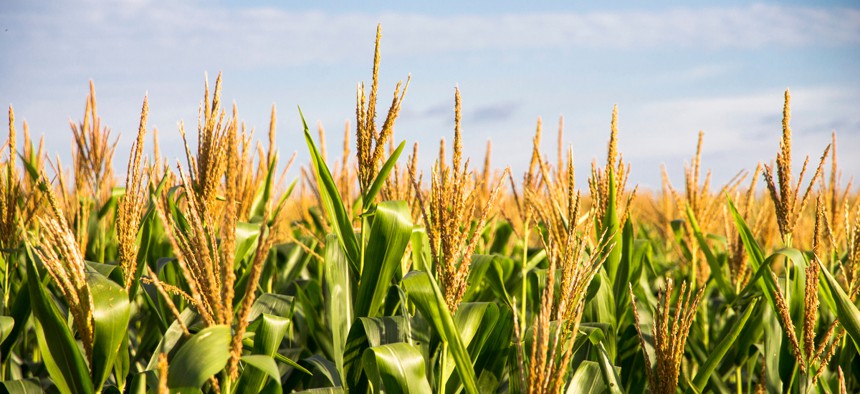How ‘Corn Sweat’ Makes Summer Days More Humid

Plants, like humans, shed water when it gets too hot. Pitagoras Abreu/Shutterstock
It’s a real phenomenon, and it’s making the hot weather muggier in the American Midwest.
As hot, sticky weather descends on much of the country this weekend, some of the stickiness in Midwestern cities may be due to an unexpected phenomenon: “corn sweat.”
That’s right. Even if you’re in the middle of a concrete jungle, those millions of acres of corn (and other crops) in the country’s heartland are still shaping your weather in powerful—and uncomfortable—ways.
“Under conditions like we have now where it’s very warm to begin with, and the atmosphere has a significant amount of moisture in it already, the crop is just adding moisture to that, making conditions feel even more humid,” said Dennis Todey, director of the U.S. Department of Agriculture’s Midwest Climate Hub.
How Corn ‘Sweats’
Plants, like humans, shed water when it gets too hot. In their case, they suck up water through their roots and then push it out through tiny holes in their leaves called stomata.
“When [water] converts from that liquid form to that gas form, it takes a lot of energy with it,” said Joe Lauer, a professor and corn agronomist at the University of Wisconsin. “The upshot is it cools the leaf down.”
But all that water a plant pushes out of its stomata goes somewhere: into the air.
The process is technically called transpiration or evapotranspiration, analogous to perspiration in animals. When it’s corn that’s evapotranspiring, the process is often dubbed “corn sweat,” a special nickname because of the prominent effect it can have on the weather.
One corn plant doesn’t make a big difference. But a full field can raise the dew point—a measure of how much water is in the air—by 5 degrees Fahrenheit. A single acre of corn can give off up to 4,000 gallons of water per day. And the U.S. has lots and lots of cornfields: more than 90 million acres.
The result is a wave of humidity that rolls across entire regions, from Denver to Pittsburgh.
The humidity from corn sweat is most pronounced in the cornfields themselves, but it reaches cities, too. There, it combines with the added heat from the urban heat island effect to create a particularly unpleasant stickiness.
“Once that moisture’s up in the air, it kind of just blows around with the general motion of the wind and weather patterns,” said Eric Ahasic, a National Weather Service meteorologist based in Minnesota.
The effect can be considerable. Ordinarily, high dew points above 80 degrees are only really seen along the coasts, especially near warm seas like the Gulf of Mexico. A day passes for humid in inland climates if the dew point passes 70 degrees.
“But what we’ve seen really develop recently in the last 10 [or] 20 years, we’ve seen those 80-degree dew points get up into the Midwest,” Ahasic said. “It’s actually that extra moisture being pumped out of the farm fields, and especially the corn.”
Corn isn’t the only plant that transpires. All plants do, including grasses, trees, and other types of crops. “That’s why … you feel cooler under trees—not only because they’re shaded, but they’re also transpiring moisture,” said Todey.
Other crops reach maximum evapotranspiration at other times of year. Soybeans, for example, tend to peak in August, while wheat often reaches its max earlier in the summer.
But this time of year, right as the summer heat is peaking, so does the evapotranspiration from those millions of acres of corn, based on their life cycle.
Stressed-Out Corn
Adding to the misery this year is the wet weather that much of the Corn Belt has received recently. All that rain means more water in the soil for corn plants to slurp up and sweat out.
From the corn’s perspective, evapotranspiration is good—a natural way to cool down when the air gets too hot. When corn can’t evapotranspirate, such as when there’s not enough water in the soil, it reacts instead by closing those stomata and curling up to try to conserve moisture. That physically stresses the plant and can be associated with lower yields, said Rebecca Vittetoe, an extension field agronomist with Iowa State University.
One saving grace for humans—though not corn—is that the extreme highs of this weekend’s heat wave might actually mean less corn sweat than if thermometers stayed in the 80s. That’s because another factor that can cause corn to undergo a stress reaction is temperatures above 90 degrees.
It’s tempting to speculate that if American agriculture were not so corn-dependent, that might bring the humidity down a little. Possibly: In the Dakotas, a recent shift to more corn and soybean production has meant more summer evapotranspiration. But it’s also true that native prairie grasses transpire a lot, too.
David Montgomery is a data visualization journalist at CityLab.
NEXT STORY: How College Towns Could Benefit More From Throngs of Student Volunteers





